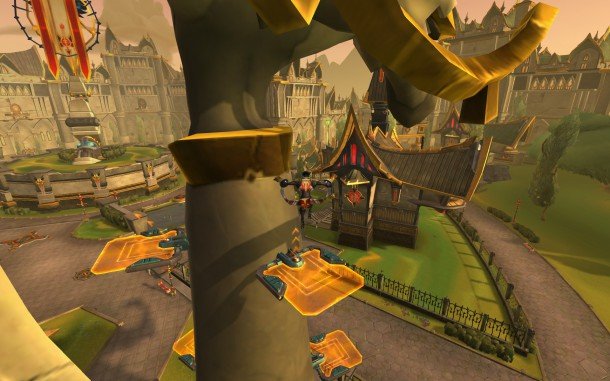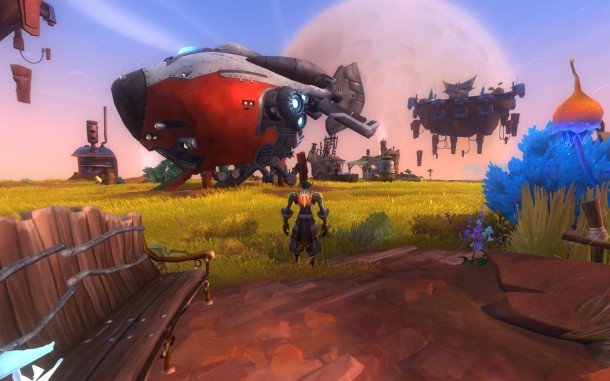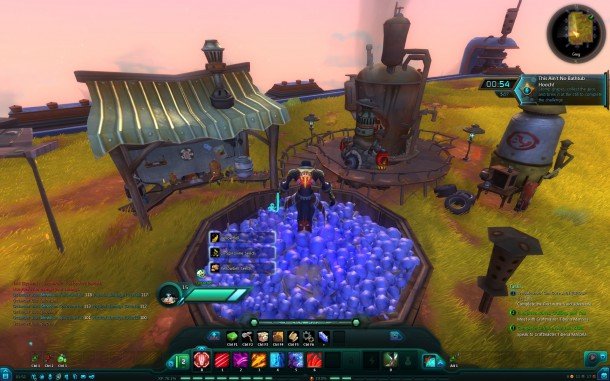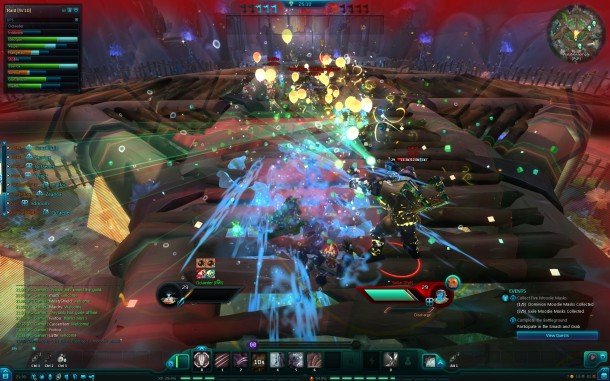Wildstar review in progress part two: Shiphand missions, housing and battlegrounds

In part one of our Wildstar review in progress, Phil examined character creation and explored the starting areas of Destiny, Levian Bay and Ellevar. Now he breaks out of levelling a bit to explore Shiphand missions, build a house, and take on other players in Wildstar's Battlegrounds.
Shiphand Missions
I decide to fight my natural urge for a tidy to-do list and take a break from open-world questing. One of my outstanding tasks is a Shiphand Mission—an off-world objective taken at the behest of a spaceship captain. It's a welcome diversion, and proves a nice change from the first few Dominion zones.
After an opening battle in which I'm defending a cargo of crystals from a steady procession of Marauders, I head out onto the outpost proper. Here the mining colony workers have been possessed by a mysterious entity, and it's my job to figure out what's going on. Primarily by killing things. Essentially, it's a campy sci-fi jaunt—a brief B-movie distraction, and all the better because of it. Hopefully the others are similarly light-hearted and brisk, because this was a refreshing standalone episode inside the colossal task of general questing.
Later, I go back and run it again, because Shiphand Missions scale in difficulty based on the number of people in your group. The first time, I went through solo, and encountered little in the way of challenge. This time, it was with four others players, providing a nice boost to the number and power of enemies.

I like grouping, and appreciate the fact that I'm being given plenty of reasons to do it. The more I team up with other players, the more I'm impressed by an element of the combat system that I hadn't initially considered. The telegraphed attacks completely change how medics function in the 'Trinity'. Rather than being a forgotten element of the party—noticeable only when they screw up—the other roles are forced to pay attention to where the manually aimed heals are being placed. Staying alive means moving into their healing cones, which livens up the group fights dramatically. Situational awareness is key in all things, and it means that the responsibility for staying alive is partly down to each individual player.
Housing
Level 14 is one of the more important milestones on the path through the game. Not only is it when you unlock player housing, but also when you can first visit your faction's capital city. And, after long hours of exploring its large mass, I am more than ready to leave Ellevar.

Illium acts as the central trading district for The Dominion. Through it you can reach other zones and continents, and inside you'll find traders, customisation shops and the auction house. It's also here that you'll be able to exchange gold for Credd—the game's Plex-style equivalent that lets you purchase in-game time. At least, it will be when the system goes online later this month.
Keep up to date with the most important stories and the best deals, as picked by the PC Gamer team.
I'm here for one thing: my house. Well, actually two things…

Okay, so three things…

With the distractions worn out, I build my house. And then I keep building my house. And then I painstakingly position a bed…
And then I buy things for my house. Lots of things, until the majority of my money is gone.

Your house sits on a hovering plot of land accessible at any time, in any place, through use of a recall ability. At its most utilitarian level, it's the place to go before you log out, as it grants a resting XP bonus for your next session. But just like a real house is—when you boil it down to its most basic level—a place to stop foxes from nibbling your toes off in the night, it also has a darker purpose: to drain you of all your money. In addition to the main structure, each plot can contain a series of bonus features. Some are purely aesthetic, like the nice garden, or the BBQ; others are functional, like the crafting table or allotment. Each of them requires gold.
You can also become neighbours with other players, letting you visit their house, judge their worth as a human being, and check out their various amusements. Chris tells me he's got a jumping puzzle in his, and I look forwarded to checking it out. In mine, there's a place where you can stomp berries to make moonshine.

This isn't an isolated system. Throughout the questing and challenge completions, you'll pick up a variety of loot that will act as decorations, giving a competitive element to how you kit out your pad. In all, I predict it's going to be a dangerous thing.
Battlegrounds
Oh right, there's a whole game out there. I should play some more of it. I figure it's time to try some of the PvP modes, and so queue up for a Battleground. These are 10v10 objective-based matches, and…

They are completely absurd.
In Walatiki Temple players must fight over a Tiki mask that spawns somewhere in the centre of the map. Bring five of them back to your base and you win, providing the other team doesn't break in and steal them. It's a neat way to ensure some big team fights, but, as the above image shows, big team fights can result in an incomprehensible patchwork of attack warnings.
The second Battleground, Halls of the Bloodsworn, was ultimately my favourite. Much like in Team Fortress 2, here you're alternating between attack and defend, taking it in turns to capture three points the fastest. It's the secondary objectives to the side of each control point that give it a more structured feel. If the attackers grab these, it makes the main point capture faster, but it also requires co-ordination and often necessitates that the team split up.
The biggest thing I learned from PvP was that my build isn't sufficient to compete. My current skill rotation has served me well in solo and group questing, but I'm going to need something more tactical to be effective against other players. This, more than anything, is what's going to drive me into the intricacies of my class.
It was during the PvP that I experienced the first, brief bit of skill lag in the game. Mostly, save for infrequent hotfix disconnects, Wildstar has been smooth in terms of connectivity. I have noticed one recurring issue: an enemy's health bar can sometimes be slow to update. So far, the only effect is that I'll occasionally attack a monster after it has died. It's a small annoyance, but its persistent enough to be noticeable.

Overall, I'm having a lot of fun with Wildstar. An important milestone came the other night, when I realised I'd stopped writing notes, taking screenshots and generally dissecting the game. I'd stopped reviewing it, and was instead playing purely for my own pleasure. That's a good sign that a game's onto something special.

Phil has been writing for PC Gamer for nearly a decade, starting out as a freelance writer covering everything from free games to MMOs. He eventually joined full-time as a news writer, before moving to the magazine to review immersive sims, RPGs and Hitman games. Now he leads PC Gamer's UK team, but still sometimes finds the time to write about his ongoing obsessions with Destiny 2, GTA Online and Apex Legends. When he's not levelling up battle passes, he's checking out the latest tactics game or dipping back into Guild Wars 2. He's largely responsible for the whole Tub Geralt thing, but still isn't sorry.

